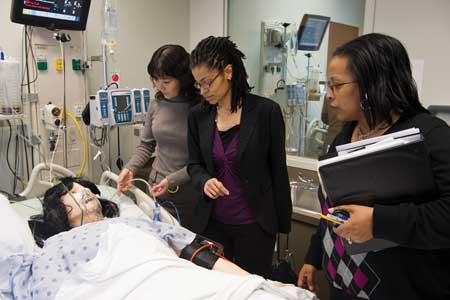Maryland’s Nurse Educators Get High-Tech at Hopkins
by Kelly Brooks

To secure a state-of-the-art education for tomorrow’s nurses, Maryland’s nurse educators must become masters of simulation technology. Faculty from 10 Maryland nursing schools learned how to incorporate simulation training in their teaching at the Maryland Faculty Academy for Simulation Teaching in Nursing (M-FAST), held on January 9–13, 2012, at the Johns Hopkins University School of Nursing.

“Simulations provide students a safe, simulated clinical environment to hone their skills, develop their problem-solving abilities, and get experience within their scope of practice,” says Pamela R. Jeffries, PhD, RN, associate dean for academic affairs at the School of Nursing. “It’s absolutely an essential part of today’s nursing education.”
Simulated patient scenarios are most effective when facilitated by an educator who understands the technology, the pedagogy, and the way that students learn—and all of these topics are taught to faculty who attend the M-FAST Academy. They learn to facilitate the student learning experience and then share their knowledge, becoming faculty trainers for their own schools and universities. In this way, M-FAST continues to improve simulation education throughout the state long after the Academy is over.
The result, says M-FAST principal investigator Linda Rose, PhD, RN, will be a cadre of nursing graduates who are well-prepared for the rigors of a nursing career. The techniques taught at M-FAST “are great for assessing student competencies, so teachers can better identify student strengths and weaknesses and develop targeted teaching to address them,” she says. The results are better rates of student retention, graduation, and passing licensure exams.
An added benefit of the program, according to M-FAST project manager Jennifer Haire, is easing the state’s nursing shortage. Nursing schools often limit their student enrollment—and therefore the number of new nurses entering the workforce each year—based on the number of clinical assignment positions available. When students spend some of their clinical time in simulation scenarios instead of real-time clinical care of patients, schools can potentially accept more students and graduate more qualified nurses.
The 10 M-FAST schools represent a wide range of nursing schools: small- and large-enrollment programs, associate and baccalaureate degree programs, and programs with varying levels of simulation expertise and resources. As they move forward, implementing new technology and pedagogy, the schools will continue to collaborate with one another and have continuing support from M-FAST instructors. Schools will also have access to aggregated data showing the impact of simulation training across the participating institutions.
The consortium includes the nursing programs of:
- Bowie State University
- Carroll Community College
- Coppin State University
- Harford Community College
- Howard County Community College
- Johns Hopkins University
- Montgomery College
- Stevenson University
- Towson University
- Wor-Wic Community College
M-FAST is a three-year program, funded by the Maryland Higher Education Commission in 2010.
Learn more about simulation at www.nursing.jhu.edu/simulation.